New Paper Airplane Distance Record
On December 2, 2022 a new world record was been set for the farthest flight of a paper airplane. We interviewed the record holders to learn more about this amazing feat.
In 2022, three friends collaborated to take on the challenge of beating the world record for the furthest flight of a paper airplane. The team, comprised of Dillon Ruble, Garrett Jensen and Nathan Erickson worked for 6 months to optimize their design and achieved a final distance of 88.318 meters (290 ft). This was 10 meters further than the previous record, set only in April of the same year and nearly 20 meters further than the ten year record set before this. We've updated our Paper Airplane World Records page with the new information, and we have had the privilege of being able to interview the team, so please continue reading to hear the details of this new world record.
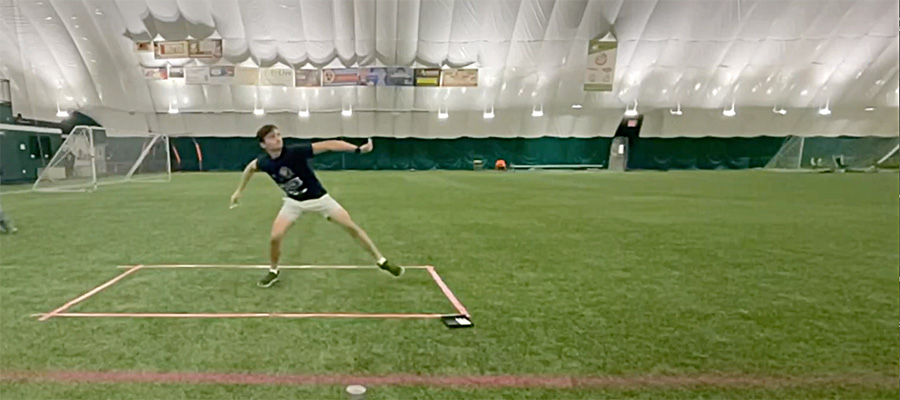
The Team
Dillon, Garrett and Nathan met in college while studying aerospace engineering. After graduation, Dillon and Garrett started jobs at Boeing and Nathan has just started working at Garmin.

and Nathan Erickson
(Dominic Alberico photo)
Fold'NFly: How did your team form? Did you know each other beforehand or did paper airplanes or Boeing bring you together?
Garrett Jensen: Each of us had interest in aerospace throughout our upbringing. Dillon and [I] both participated in paper airplane events at Boeing - St. Louis in middle school. Nathan and his family always made a point to visit various Space and Aircraft museums while traveling, which helped develop the passion at an early age. We all studied Aerospace and Mechanical Engineering together at the Missouri University of Science and Technology in Rolla, Missouri. In Spring 2022, Dillon competed in the Red Bull Paper Wings competition, and, after design optimization, earned himself a spot on Team USA to compete in Austria.
From the moment Dillon came back from Red Bull Paper Wings up to the day of the [record breaking] event, we collaborated to innovate and push the record farther than anyone ever thought possible. Breaking records is about more than just a number, it's about challenging yourself to reach just a little farther, work a little harder. For us, this came quicker than expected but not without significant trials and tribulations along the way. We value the drive to improve ourselves, our designs, and the world around us. Through this accomplishment, we hope to spark creativity, inspire people to chase their dreams, and foster engineering minds in the next generation.
The Process
According to the Boeing press release2, the team studied aerodynamics and origami techniques and spent over 400 hours perfecting their design. Over the 6 month project they created more than 20 different prototypes and folded hundreds of airplanes in their attempt to fly higher and further. Interestingly, the team used computer simulations to discover that the optimal angle to throw their airplane was at 40 degrees. We were curious about their prototyping process and simulation software that they used.
Fold'NFly: Please tell us about your process for refining your winning design. When you were testing a prototype, what sort of data did you collect and how did you decide what changes to make for the next iteration?
Garrett: Full-scale and paper airplanes have vast differences in their complexity, but both operate on the same fundamental principles. Some of the same design methodologies can be applied to both. One of these methods was our trial-and-error design process, both on throwing technique and aircraft design. For instance, we would theorize about an aspect of our plane we want to modify, fold it, throw it, and compare the distance to previous iterations to determine if the change was beneficial. While our database of flight data was not as developed as Boeing – St. Louis’, this testing method highlights the importance of rigorous experimenting in the real world.
Fold'NFly: You ran computer simulations to help improve your design. Can you please share some information about how you ran these simulations?
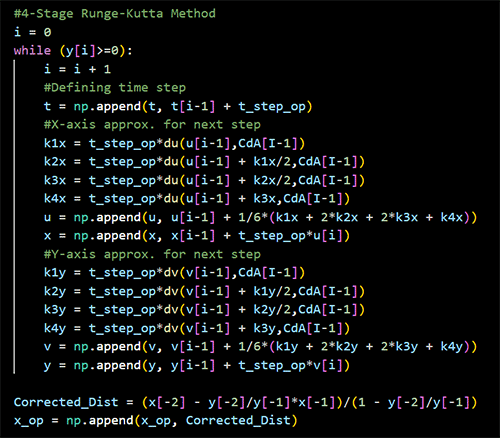
Garrett: The simulations were simple in comparison to what some people expect. For our purposes, we created a two-dimensional trajectory of our plane. This means the plane was able to go up/down and forward/backward. The "software" was Python code which is an open-source programming language. We decided to use Python since it's one of the languages of choice for our college classes.
The code that we developed is based around an Ordinary Differential Equation(ODE) solver. This may sound complicated, but it's just a way we solved the summation of forces in the forward/back and up/down directions for our plane. These forces give us accelerations on the plane, which gives us the change in velocity, which then allows us to solve for our horizontal and vertical distances that the plane has traveled. Using these distances, we can plot its flight path.
The main use of this code for us was two-fold (Ha). The first use was to find the maximum height of the airplane to pick an appropriate indoor space. Once we have the simulated flight of our plane, we can pick the tallest point on our flight path to find this. The caveat to this is that our coefficient of lift and drag are estimated using values obtained in testing. The second use was to find the best launch angle to throw the plane. We found this by simulating a variety of different throwing angles to choose the optimal one.
Fold'NFly: Did you start with a paper design and then create a digital twin for the simulations, or did you start with a digital 3D model and then reverse engineer how to fold it?
Garrett: We created a 3D model that was similar in nature to the final design, but not an exact replica. Additionally, we eventually 3D-printed this for personal display. The folding pattern was developed as we determined what features were most aerodynamically important in the design.
However, we never made a digital twin of our plane for testing purposes. The reason we could simulate the plane at all was because we already knew the fundamental forces of lift and drag acting on it. This is greatly beneficial because if we had the digital twin of our aircraft up to date with all the design changes, we would likely need to quit our full-time jobs. Not to mention the act of creating an accurate model induces errors which are separate from simulation errors. The moral of the story is that modeling the geometry of our plane would be very difficult and even more so to get an accurate model.
Fold'NFly: Can you share any more details about your simulation software?
Garrett: Here's some images of our code and subsequent output. The angle vs distance plot and optimizer graph is one of our key outputs.

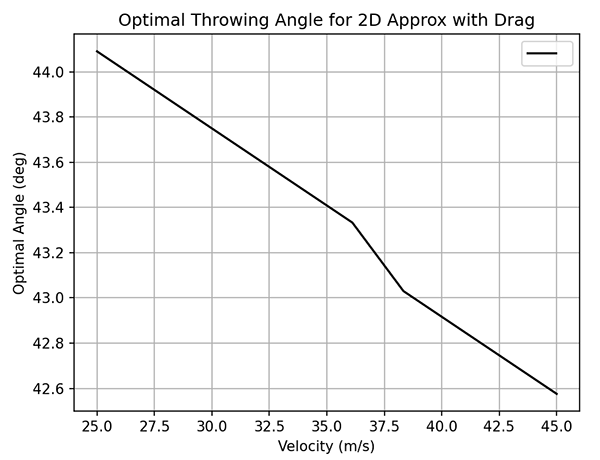
Garrett: The optimizer plot [top left] is just for bug checking and seeing if the algorithm converged to a stable solution. It basically uses a slightly modified version of Secant Method. The angle vs distance plot [bottom left] is where we take the optimized CdA value and vary the release angle to find the best throwing angle. The useful data here is not only the best release angle, but also that the distance doesn't fall off too fast. This means the thrower doesn't have to be spot on to get close to the maximum distance.
The velocity vs optimal angle plot [right] plot was a case where we found information which is interesting, but not very practical for the thrower. It basically says the faster you throw, the lower angle you should throw to maximize distance. This is because as you go faster you will have exponentially more drag which "steals" away your velocity. To fight this, you need to throw lower to use what velocity you have to gain horizontal distance before it disappears from drag. Like I said before this is interesting but not very practical because for our velocity range the best angle only changes by 0.8-1 degree. This is too small to hit accurately for a thrower, and as we can see from the previous angle vs distance plot, small changes in angle from optimal don't affect distance too much. The reason I included this plot is because not every discovery needs to be a breakthrough. Sometimes you find information and relationships which don't seem useful but help you to understand the problem you're trying to solve.
The Winning Airplane
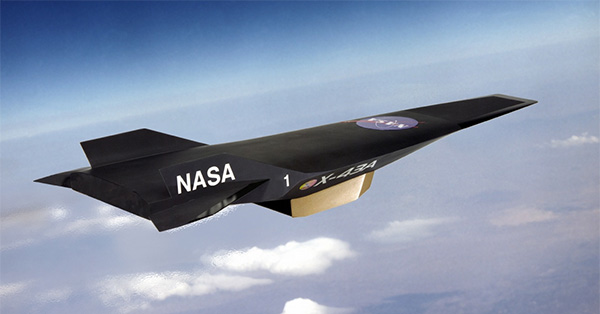
While the winning design is still a closely held secret and confidential Boeing intellectual property, we have been able to glean some minor details from various sources. As Dillon said in the Boeing press release2: "We tried to mimic the design of various hypersonic vehicles, which travel at speeds over Mach 5 (five times the speed of sound). So, we decided to call our plane Mach 5... Our design is a little different from your traditional fold in half, fold the two corners to the middle line down the middle. It's pretty unique in that aspect. It's definitely an unusual design."
Distance based paper airplanes have traditionally been "glider" type models with wide wings designed to stay aloft as long as possible and glide slowly in a straight line. This team's winning design falls more into the "dart" category that flies quickly through the air along a mostly parabolic arc. In a video of the record breaking throw4, you can get a brief glimpse of the design, and it looks like a thin dart. A photo of an early prototype (seen here) reinforces this theory. Maybe this is the new shape for record breaking paper airplanes?

their paper airplane
Guinness World Records regulations permit paper airplanes to be folded with A4-sized paper which is an international standard and about 3% larger than US based Letter paper. The maximum density of paper allowed is 100g/m2. More mass means more momentum at the point when the paper airplane is released. The team went with these maximum allowances for their winning design. If you are interested in learning more about paper size and weight, please check out our experiments on paper size and paper weight as it relates to paper airplanes.
According to Dillon, the final design requires 15 folds to complete the sequence.
The Event

the paper airplane
(Dominic Alberico photo)
The event was held on Dec 2, 2022 at the Sparta Dome in Crown Point, Indiana. It was held indoors, as per the rules, to prevent wind from helping (or hurting) the attempt. Numerous witnesses, surveyors and coordinators were on hand to make sure that the event went smoothly and that measurements were made correctly. For the attempt, Nathan folded the airplane with witnesses ensuring that no rule violations were made. For example, the maximum amount of tape allowed is 25mm x 30mm and no glue, tears or cuts are permitted. It takes Nathan more than 20 minutes to accurately fold their "Mach 5" design.
Dillon was a college baseball pitcher, so he was the smart choice to throw the airplane. Hundreds of practice throws were needed to perfect the approach, angle and release of the paper airplane in order to maximize the momentum, height and distance. The record was achieved on the third throw of the day.
Dillon announced the results on Instagram3: "Still in shock with the end result of just how far we actually got, we were hoping to get just over 80 meters and we knew we had gotten 84-85 meters on some outlier max throws, but 88.318m was incredible. Very much exceeded expectations as this was our first test flights with the new plane in an indoor environment (wind is a notable factor). Absolutely a dream come true moment for myself and this team..."
What's Next
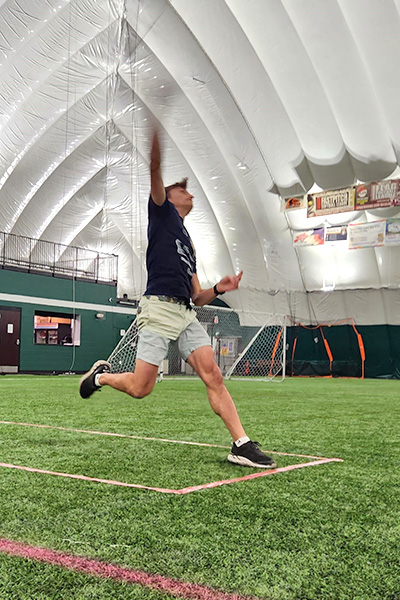
(Dominic Alberico photo)
When asked about their future plans, Dillon said "Garrett and [I] are 2nd and 3rd generation Boeing employees, respectively, so it has always been a dream to work for the company. [I am] a systems engineer at Boeing, and Garrett is a strength engineer at Boeing. Nathan recently joined the Flight Control Systems team at Garmin and loves the culture of the company. As collegiate triathletes, all of us relied on Garmin GPS watches to propel our training each week."
"For [me], the journey is not over. The next Red Bull Paper Wings competition is in 2025 and [I am] looking forward to competing as well as testing new paper airplane designs. For the rest of us, we hope to take everything we have learned to create new, exciting designs. In fact, 'Mach 5' may one day see the inside of a wind tunnel."
1) Farthest Flying Paper Airplane Guinness World Records
2) Duo’s paper airplane seizes Guinness World Records status Boeing News Now
3) Dillon Ruble (__thepaperpilot__) Instagram
4) Video Summary of Event YouTube